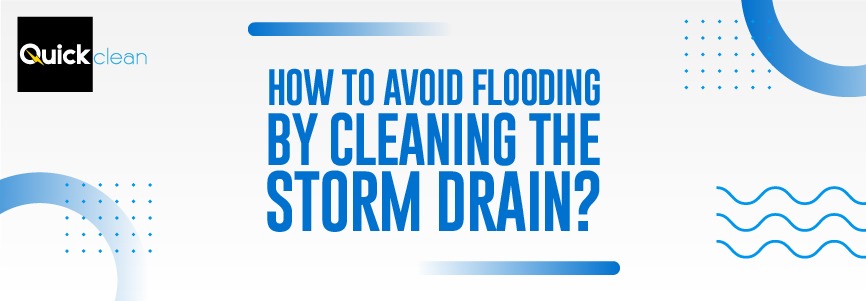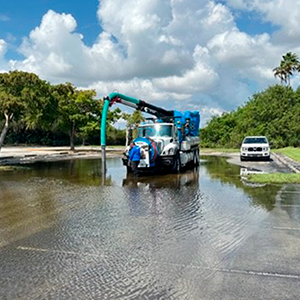As April showers begin to drench the vibrant city of Miami, the risk of flooding escalates, turning attention to a critical yet often overlooked component of urban infrastructure: the storm drain. Cleaning the storm drains in Miami is paramount in preventing the undesirable consequences of water buildup, which can lead to flooding, property damage, and disrupted daily life.
This article explores effective strategies for cleaning storm drains and the potential fallout of neglecting this essential task.
Importance of Storm Drain Maintenance in Miami
Miami, known for its beautiful coastlines and tropical climate, also experiences significant rainfall, especially during the spring months. This increases the city’s susceptibility to flooding, making storm drain maintenance not just a precaution but a necessity.
Storm drains are designed to channel rainwater from urban areas to nearby water bodies, preventing the accumulation of excess water on streets and properties. However, when these drains become clogged with debris, their efficiency is compromised.
Tips for Cleaning the Storm Drains in Miami
Regular Inspections and Cleaning
The first step in avoiding flooding is to conduct regular inspections of storm drains. Look for visible signs of blockage, such as debris covering the grate or water pooling around the drain during light rainfall. These are indicators that the storm drain requires immediate attention.
Clearing Debris and Obstructions
Leaves, trash, and branches can easily clog storm drains, preventing water from flowing through. Regularly removing debris from the surface of the drain is a simple yet effective way to maintain its functionality. It’s a task that residents and local businesses can undertake to contribute to the community’s well-being.
You may be interested in: 5 tips to protect your business and storm drain from flooding
Professional Maintenance and Cleaning
While surface cleaning can be managed individually or by municipal services, the intricate work of deep cleaning a storm drain system requires professional expertise. This involves inspecting the drain’s interior, removing sediment buildup, and ensuring that the drainage pipes are clear of obstructions. You can see ahead why Quick Clean is the top choice for cleaning the storm drains in Miami.
Installation of Guards and Filters
To prevent debris from entering the storm drain system, consider installing guards or filters over the drains. These devices can capture larger pieces of waste while allowing water to pass through, significantly reducing the risk of clogs.
Consequences of Neglecting Storm Drain Cleaning
Flooding and Property Damage
The most immediate consequence of a clogged storm drain is flooding. Water that cannot enter the drain will instead accumulate on streets and, in severe cases, enter homes and businesses, causing extensive property damage.
Health and Safety Risks
Standing water is a breeding ground for mosquitoes and other pests, posing significant health risks to the community. Moreover, flooded streets can become hazardous for pedestrians and drivers, increasing the likelihood of accidents.
Environmental Impact
When storm drains are overwhelmed, the chance of pollution entering natural water bodies increases. Debris, chemicals, and waste can be carried by floodwater into rivers and oceans, harming aquatic ecosystems.
Why did flooding in Miami happen?
Miami’s susceptibility to flooding is primarily due to its unique geographical location and meteorological conditions. Situated on the southeastern coast of Florida, Miami is bordered by the Atlantic Ocean on one side and the Everglades wetland area on the other. This coastal and low-lying geography makes the city prone to flooding for several reasons.
Geographical and Meteorological Factors
Storm Surges
As a coastal city, Miami is vulnerable to storm surges caused by hurricanes and tropical storms. A storm surge occurs when strong winds push water towards the shore, which can rise well above the normal tide levels, leading to significant flooding in coastal areas.
Heavy Rainfall
Miami’s tropical monsoon climate results in high precipitation levels, especially during the summer and early fall. The intense and often sudden downpours can overwhelm the city’s drainage systems, leading to rapid accumulation of water on streets and low-lying areas.
Flat Topography
Miami’s flat terrain lacks natural drainage routes for rainwater to flow away from urban areas. The elevation gradient is minimal, which means water does not naturally flow as quickly into drainage channels, rivers, or the ocean.
Groundwater and High Tides
Miami’s proximity to the Biscayne Aquifer means that the groundwater is often just a few feet below the surface. During king tides, which are exceptionally high tides that occur a few times each year, the sea level can rise enough to push water back through the drainage systems, leading to flooding even on sunny days. This phenomenon, known as “sunny day flooding,” is becoming more common in Miami.
Human-Induced Factors
Urbanization
The development of urban areas with impermeable surfaces such as roads, parking lots, and buildings decreases the amount of land available for rainwater to infiltrate into the ground. Instead, more water runs off into the drainage system, increasing the load on sewers and canals and raising the risk of overflow.
Drainage and Sewer Systems Capacity
Although Miami has made significant investments in improving its drainage and sewer systems, some areas still have outdated or inadequate infrastructure. This can result in bottlenecks during heavy rainfall events, where the system cannot handle the volume of water, leading to localized flooding.
Sea-Level Rise
Climate change is contributing to a gradual rise in sea levels, which affects Miami due to its coastal location. Higher sea levels mean that storm surges can push further inland, and the city’s ability to drain flooded areas is compromised since the gradient between land and sea decreases, slowing down the drainage of floodwater back into the ocean.
Quick Clean: Your Professional Storm Drain Cleaning Solution in Miami
In light of the essential tips for cleaning the storm drains in Miami and the dire consequences of neglect, it becomes clear that professional intervention is often the best course of action. This is where Quick Clean excels. Specializing in comprehensive storm drain cleaning services in Miami, Quick Clean is equipped with state-of-the-art technology and a team of experienced professionals dedicated to ensuring that your storm drains function optimally.
Quick Clean’s approach encompasses a thorough assessment of your storm drain system, identifying potential problem areas, and employing advanced cleaning techniques to remove blockages and buildup. Our services not only aim to prevent flooding but also to extend the lifespan of your storm drain system, making it a cost-effective solution for Miami residents and business owners alike.
Choosing Quick Clean for your storm drain maintenance needs means investing in the safety, health, and environmental well-being of your community. Our commitment to excellence and customer satisfaction ensures that you receive the best possible service, tailored to meet the unique challenges presented by Miami’s climate.
As we welcome the April rains, let’s not forget the crucial role that storm drains play in our urban ecosystem. By prioritizing the maintenance of these vital systems, we can collectively mitigate the risk of flooding, safeguarding our properties, and ensuring the health and safety of our communities.
And remember, when it comes to reliable, efficient storm drain cleaning in Miami, Quick Clean stands ready to serve. Don’t wait for the waters to rise; contact Quick Clean today and take a proactive step towards flood prevention.

